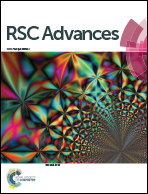Investigation of the dinuclear effect of aluminum complexes in the ring-opening polymerization of ε-caprolactone†
Abstract
A series of aluminum (Al) complexes bearing hydrazine-bridging Schiff base and salen ligands were synthesized and investigated as catalysts for the ring-opening polymerization of ε-caprolactone (CL). The introduction of steric bulky groups increases the catalytic activity of the corresponding mononuclear aluminum complex. However, the opposite phenomenon was observed in dinuclear Al complexes bearing salen ligands because the steric repulsion reduced the cooperative activation mechanism in the dinuclear Al system. Among these Al complexes, LN2Bu-Al2Me4 bearing a hydrazine-bridging Schiff base ligand had the highest catalytic activity, approximately 3- to 11-fold higher than that of dinuclear Al complexes bearing salen ligands and mononuclear Al complexes bearing Schiff base ligands. Density functional theory calculations revealed that the mechanism of the coordination of CL to one Al center was initiated by the benzyl alkoxide of another Al center.



 Please wait while we load your content...
Please wait while we load your content...